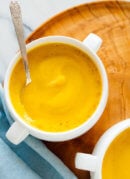Roasted Butternut Squash Soup
- Author:
- Prep Time: 10 mins
- Cook Time: 55 mins
- Total Time: 1 hour 5 minutes
- Yield: 4 bowls or 6 cups 1x
- Category: Soup
- Method: Roasted and blended
- Cuisine: American
This homemade butternut squash soup is the best I’ve ever tasted! This recipe is super creamy (yet cream-less) and full of delicious butternut flavor. Leftover soup tastes even better the next day. Recipe yields about 4 bowls or 6 cups of soup.

Ingredients
- 1 large butternut squash (about 3 pounds), halved vertically* and seeds removed
- 1 tablespoon olive oil, plus more for drizzling
- 1/2 cup chopped shallot (about 1 large shallot bulb)
- 1 teaspoon salt
- 4 garlic cloves, pressed or minced
- 1 teaspoon maple syrup
- 1/8 teaspoon ground nutmeg
- Freshly ground black pepper, to taste
- 3 to 4 cups (24 to 32 ounces) vegetable broth, as needed
- 1 to 2 tablespoons butter, to taste
Instructions
- Preheat the oven to 425 degrees Fahrenheit and line a rimmed baking sheet with parchment paper. Place the butternut squash on the pan and drizzle each half with just enough olive oil to lightly coat the squash on the inside (about 1/2 teaspoon each). Rub the oil over the inside of the squash and sprinkle it with salt and pepper.
- Turn the squash face down and roast until it is tender and completely cooked through, about 40 to 50 minutes (don’t worry if the skin or flesh browns—that’s good for flavor). Set the squash aside until it’s cool enough to handle, about 10 minutes.
- Meanwhile, in a large soup pot, warm 1 tablespoon olive oil over medium heat until shimmering (if your blender has a soup preset, use a medium skillet to minimize dishes.) Add the chopped shallot and 1 teaspoon salt. Cook, stirring often, until the shallot has softened and is starting to turn golden on the edges, about 3 to 4 minutes. Add the garlic and cook until fragrant, about 1 minute, stirring frequently. Transfer the contents to your stand blender (see notes on how to use an immersion blender instead).
- Use a large spoon to scoop the butternut squash flesh into your blender. Discard the tough skin. Add the maple syrup, nutmeg and a few twists of freshly ground black pepper to the blender. Pour in 3 cups vegetable broth, being careful not to fill the container past the maximum fill line (you can work in batches if necessary, and stir in any remaining broth later).
- Securely fasten the lid. Blend on high (or select the soup preset, if available), being careful to avoid hot steam escaping from the lid. Stop once your soup is ultra creamy and warmed through.
- If you would like to thin out your soup a bit more, stir in the remaining cup of broth. Add 1 to 2 tablespoons butter or olive oil, to taste, and blend well. Taste and stir in more salt and pepper, if necessary.
- If your soup is piping hot from the blending process, you can pour it into serving bowls. If not, pour it back into your soup pot and warm the soup over medium heat, stirring often, until it’s nice and steamy. I like to top individual bowls with some extra black pepper.
Notes
*How to safely slice your butternut squash: You’ll need a sharp chef’s knife and a slip-free cutting board (place a lightly damp tea towel beneath your cutting board to keep it from moving around). Use the knife to cut off the tip-top and very bottom ends of the squash. Stand the squash upright with the thickest flat side as the base. Carefully slice through it from top to bottom to divide it in half (your fingers should never be in the blade’s way). Lastly, use a large spoon to scoop out the seeds and discard them.
Make it dairy free/vegan: Substitute high-quality olive oil for the butter. It will make your soup taste luxurious and lightly herbal.
Storage suggestions: Let leftover soup cool to room temperature before transferring it to a proper storage container and refrigerating it for up to 4 days (leftovers taste even better the next day!). Or, freeze this soup for up to 3 months.
If you are working with an immersion blender: Cook the shallot mixture in a large soup pot. Then add the scoops of cooked butternut squash, all 4 cups of broth, maple syrup, nutmeg and a few twists of freshly ground black pepper. Bring the mixture to a simmer and cook, stirring occasionally, for 15 to 20 minutes so the flavors have a chance to meld. Carefully use your immersion blender to blend the soup completely, then add 1 to 2 tablespoons butter or olive oil, to taste, and blend again. Taste and blend in more salt and pepper, if necessary.
▸ Nutrition Information
Recipe from Cookie and Kate: https://cookieandkate.com/roasted-butternut-squash-soup/
